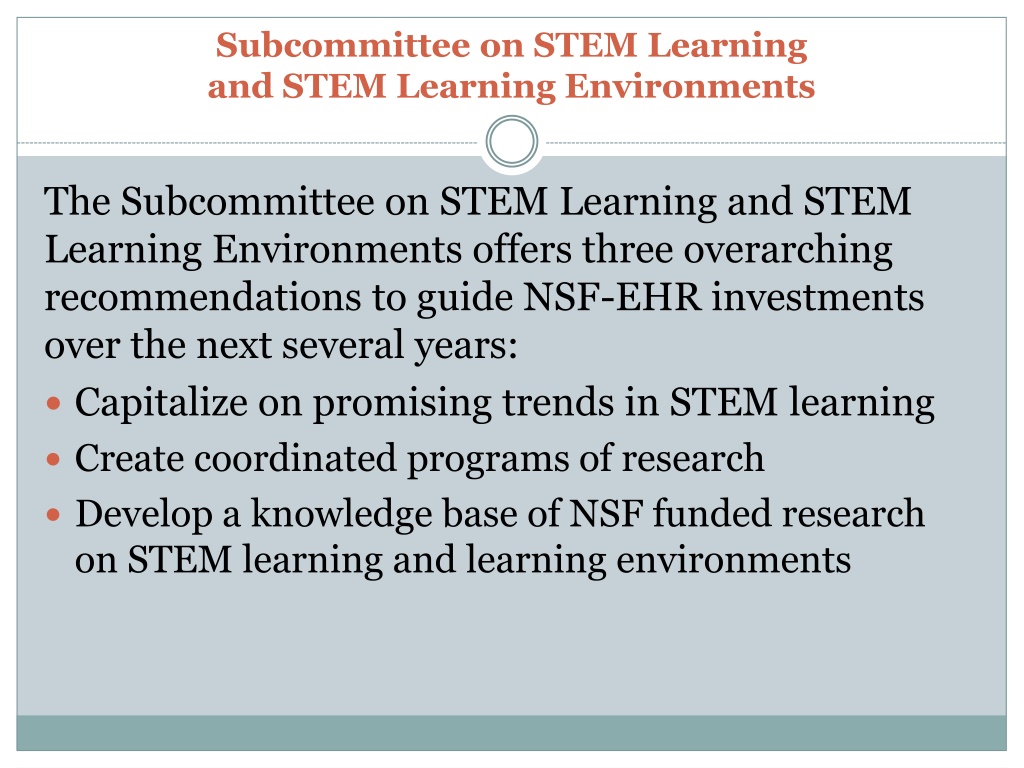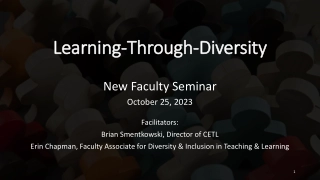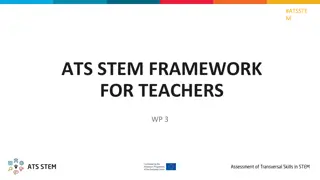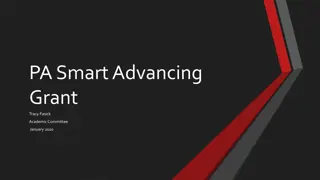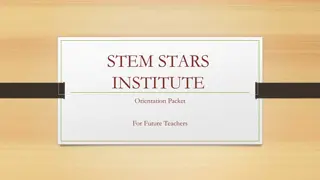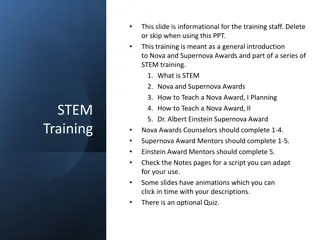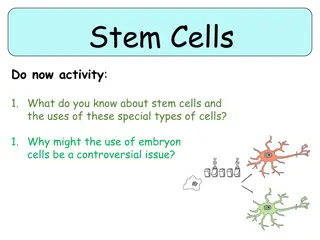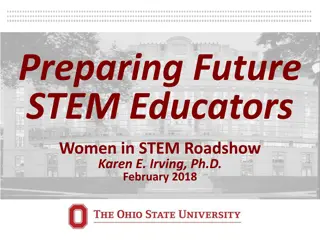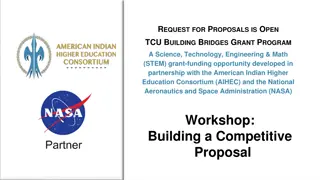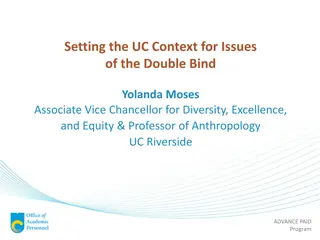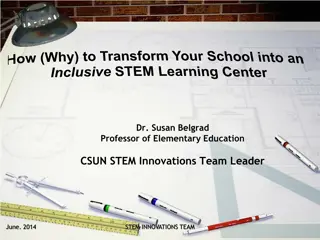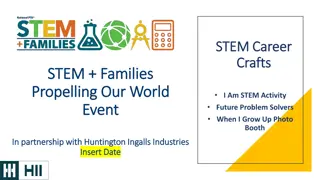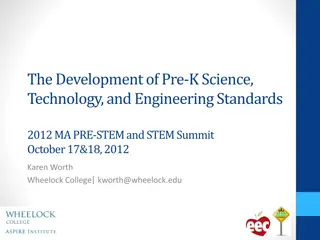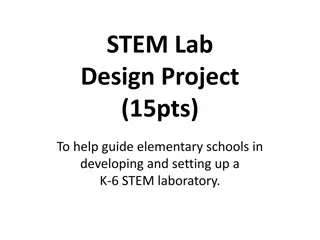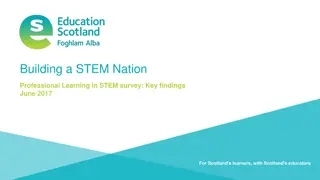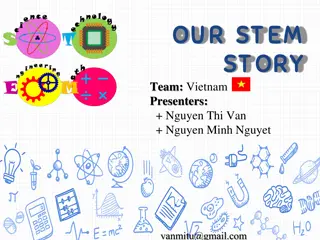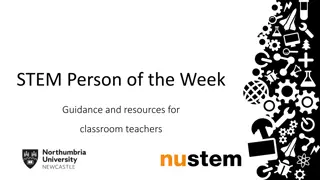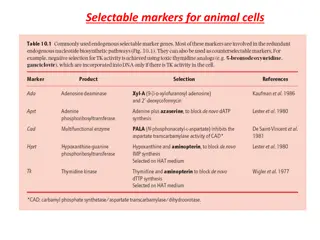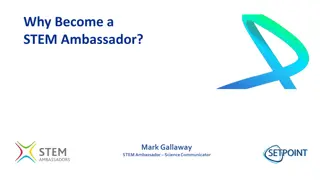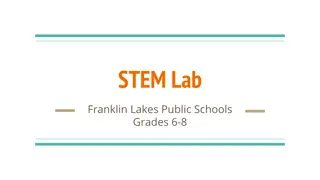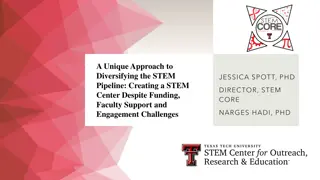Recommendations for Advancing STEM Education
The Subcommittee on STEM Learning and STEM Learning Environments provided three key recommendations for guiding NSF-EHR investments in the coming years. These recommendations include capitalizing on emerging trends in STEM learning, developing coordinated research programs, and creating a knowledge base of NSF-funded research in STEM learning and learning environments. By leveraging opportunities like cyberlearning, multi-modal analytics, and addressing human subject protections, the field of STEM education can be further advanced for all American students.
Download Presentation

Please find below an Image/Link to download the presentation.
The content on the website is provided AS IS for your information and personal use only. It may not be sold, licensed, or shared on other websites without obtaining consent from the author.If you encounter any issues during the download, it is possible that the publisher has removed the file from their server.
You are allowed to download the files provided on this website for personal or commercial use, subject to the condition that they are used lawfully. All files are the property of their respective owners.
The content on the website is provided AS IS for your information and personal use only. It may not be sold, licensed, or shared on other websites without obtaining consent from the author.
E N D
Presentation Transcript
Subcommittee on STEM Learning and STEM Learning Environments The Subcommittee on STEM Learning and STEM Learning Environments offers three overarching recommendations to guide NSF-EHR investments over the next several years: Capitalize on promising trends in STEM learning Create coordinated programs of research Develop a knowledge base of NSF funded research on STEM learning and learning environments
Subcommittee on STEM Learning and STEM Learning Environments 1. Capitalize on promising trends in STEM learning Context: a confluence of major forces Recognition of the role of postsecondary education and STEM skills New education standards, including CCSS and NGSS New information, communication, and collaborative technologies The rise of improvement science and its application to data collection, analyses, and pedagogical practice Understanding that learning occurs across environments and the lifespan These trends in the wider field of education open significant new opportunities to improve STEM learning for all American students.
Subcommittee on STEM Learning and STEM Learning Environments 1. Capitalize on promising trends in STEM learning Opportunities Encourage researchers and practitioners to improve the field s understanding of core questions Exploit the potential of cyberlearning to accelerate and personalize STEM learning Study shifts in educators roles in the STEM disciplines Employ multi-modal learning analytics and data-intensive methods to address educational questions (e.g., STEM performance assessments) Take leadership to engage emerging concerns for human subjects protections in STEM learning environments
Subcommittee on STEM Learning and STEM Learning Environments 2. Create coordinated programs of research Context: common problems of practice Growing capacity in the field to identify common problems of practice, including stumbling blocks to student learning Potential to raise levels of STEM learning for girls and young women and students from underrepresented racial and ethnic groups Technology infrastructure and improvement science open new ways to expand field participation in designing and testing solutions NSF investment should be designed to spark broad interest, understanding, and dialogue about how problems can be solved and solutions applied.
Subcommittee on STEM Learning and STEM Learning Environments 2. Create coordinated programs of research Opportunities Build knowledge about how to recognize and overcome common stumbling blocks that hamper student learning. Examples include: Understanding rational numbers, ratios and proportional reasoning Applying core concepts and problem-solving strategies for computational thinking Other potential high-leverage topics include: Mastering interdisciplinary Overcoming barriers that limit the success of underrepresented students in postsecondary STEM learning
Subcommittee on STEM Learning and STEM Learning Environments 3. Develop a knowledge base of NSF-funded research Context: coordination and transparency New NSF/IES guidelines provide a basis for coordinated, transparent programs of knowledge generation Programs should encompass projects across research types, including foundational, design and development, impact, scaling, and evaluation Balanced portfolios could help fill gaps and drive evidence and theory toward development, design, and implementation. Greater transparency about NSF priorities and how NSF-funded research efforts fit together could help educators, researchers, and others in the field to recognize potential connections with their work.
Subcommittee on STEM Learning and STEM Learning Environments 3. Develop a knowledge base of NSF-funded research Opportunities Develop a logic model and associated schematics that articulate the Directorate s vision Strengthen relationships with educators and others to identify high- leverage topics Broaden participation by practitioners and researchers, especially those from underserved populations Establish and/or charge translational research centers with developing common standards for collecting and tagging data
